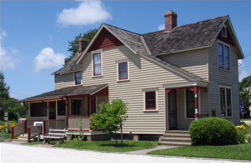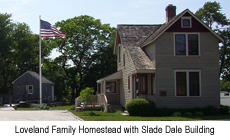About Bay Head Historical Society Museum
The Loveland Homestead
Built in 1867, addition in 1887
Slade Dale Cottage 1925
When members of the Loveland family settled in this area around 1837, the land at the head of Barnegat Bay was sheltered from the sea by high sand dunes covered with sea grasses where bay berries and beach plum bushes grew in abundance. There were cranberry bogs, marshlands and fresh water lakes which provided a habitat for the birds and migratory fowls that later attracted gunners to the region.
The first purchasers of this land, which later became the hamlet known as Lovelandtown, were Judah Allen, who came here from New England in 1685, and John Hance. At the time this area was part of Shrewsbury Township, County of Monmouth, Province of East Jersey under the reign of King James II of England.
As the Loveland family grew, the family steadily increased its land holdings in the area. The members married into prominent local families from Point Pleasant and Brick and continued to develop their neighborhood throughout the late 1800's.
At the same time in the mid-1800's three land developers from Princeton, Messrs. Howe, Mount and Harris arrived and bought the land eastward that was to become Bay Head. Developed from the beginning as a resort community for the upper middle class, Bay Head attracted many affluent families from both New York and Philadelphia, thanks to the developers attracting two railroad lines to the town. The Jersey Central arrived from New York in 1882 while Pennsylvania Railroad came across the bay through Trenton and Toms River. Last stop for both was Bay Head.
 At one time before the turn of the 20th century the members of Loveland town (now a section of Point Pleasant, Ocean County) considered becoming a part of Bay Head, but the wisdom at the time thought it best to maintain the status quo. Nonetheless, many Loveland family members were very important in the now developing Bay Head. Edward Loveland was a member of the first town council of Bay Head and later, after his brother George, the dockmaster of the Bay Head Yacht Club which itself was built on the former site of James Loveland's boat dock. Celestine Loveland helped in the start of St. Paul's United Methodist Church in Bay Head while her husband John E. Loveland was the most prominent bay captain of his day.
At one time before the turn of the 20th century the members of Loveland town (now a section of Point Pleasant, Ocean County) considered becoming a part of Bay Head, but the wisdom at the time thought it best to maintain the status quo. Nonetheless, many Loveland family members were very important in the now developing Bay Head. Edward Loveland was a member of the first town council of Bay Head and later, after his brother George, the dockmaster of the Bay Head Yacht Club which itself was built on the former site of James Loveland's boat dock. Celestine Loveland helped in the start of St. Paul's United Methodist Church in Bay Head while her husband John E. Loveland was the most prominent bay captain of his day.
John W. and Samuel Loveland were the largest landholders in the area. They were joined by other early settlers, notably the Cook family and the Stout family, and were linked to these through marriage.
In 1867 the Loveland Homestead, currently the home to The Historical Society Museum, was built by Charles Stout for his daughter Lorah Stout upon her marriage to Charles Cook. By 1887 the family had grown and the back part of the house was added on to accommodate their 7 children.
The Loveland family acquired the house in the early 1900's and continued to live here until the Bay Head Historical Society purchased the property in 1997. At that time the house had fallen into disrepair and after a two year renovation (mostly exterior), the homestead opened as The Historical Society Museum in 1999. The Dale building was acquired by The Historical Society and moved to the property in 2001.
The Loveland Homestead houses artifacts, memorabilia, photographs, furniture, decoys and other treasures from the early Bay Head/ Mantoloking/Lovelandtown years. Worthy of note are the original Gerald Hardenbergh paintings and the carved Kenneth Loveland and Birdsall decoys. All three off these local artists have gained recognition in many areas outside New Jersey.
The photo collection contributed by William Schoettle is equally noteworthy for its comprehensive look at the area as it was in its heyday (mid-1880's to about 1940). The collection is part of the museums archives and is exhibited frequently.
 The Slade Dale cottage is, in part, a celebration of the sailors of Barnegat Bay. It is also an homage to the man who, as a young man, was a noted sailor in the area and who continued throughout his life to engage in truly memorable sea voyages and bay races. He built his dream marina, the Dale Yacht Basin, through his foresight of bringing outboard motors to the area. He then promoted boating of all kinds throughout the years from the 1940's to mid-1960's. For many of those years he lived in his cottage at the end of the dock at the marina.
The Slade Dale cottage is, in part, a celebration of the sailors of Barnegat Bay. It is also an homage to the man who, as a young man, was a noted sailor in the area and who continued throughout his life to engage in truly memorable sea voyages and bay races. He built his dream marina, the Dale Yacht Basin, through his foresight of bringing outboard motors to the area. He then promoted boating of all kinds throughout the years from the 1940's to mid-1960's. For many of those years he lived in his cottage at the end of the dock at the marina.
The gardens on the property represent a typical Victorian garden, a lilac memorial garden, an herb garden, a sea grass garden and a resting patio.


